Helen Britton is an eminent contemporary artist whose art transforms the profane into the precious. Elena Alvarez Lutz has now turned her philosophy into a film. This review is based on the documentary’s German premier at Dok.Fest Munich. Alvarez Lutz has submitted the documentary to film festivals around the globe, so you should have an opportunity to see it soon. When AJF receives any information on screenings, we’ll update this page and the Report.
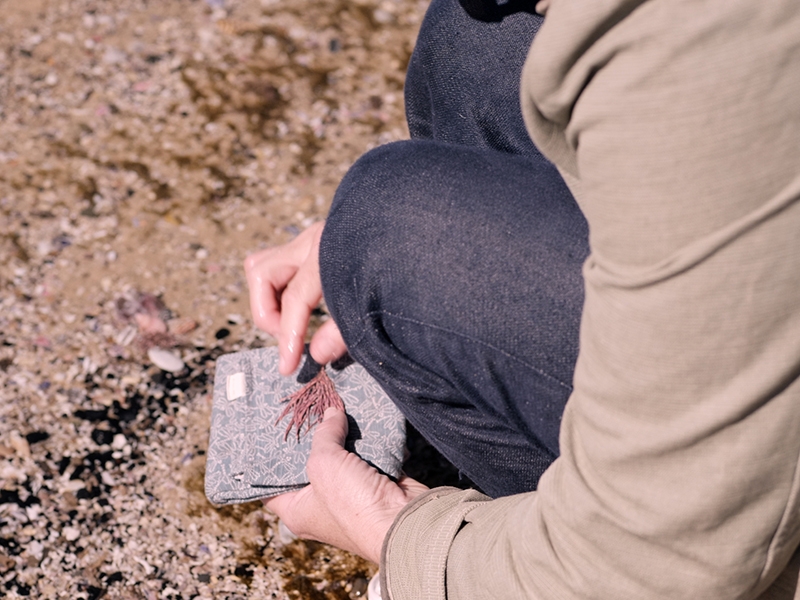
With bare feet, Helen Britton roams the sandy tide pools of Newcastle, in southeastern Australia. Among the green seaweed, she comes across a pale pink shell, and next to it a barnacle with small openings that looks like a tiny UFO. She picks up the shells and arranges them into a palm-sized ensemble. With her finger, she points to the rounded shapes of the entrances of the shell, gaping empty and abandoned by the former occupant, the crab, and mentions the flamboyant purple of the barnacle. “It’s typical for the region,” she says.
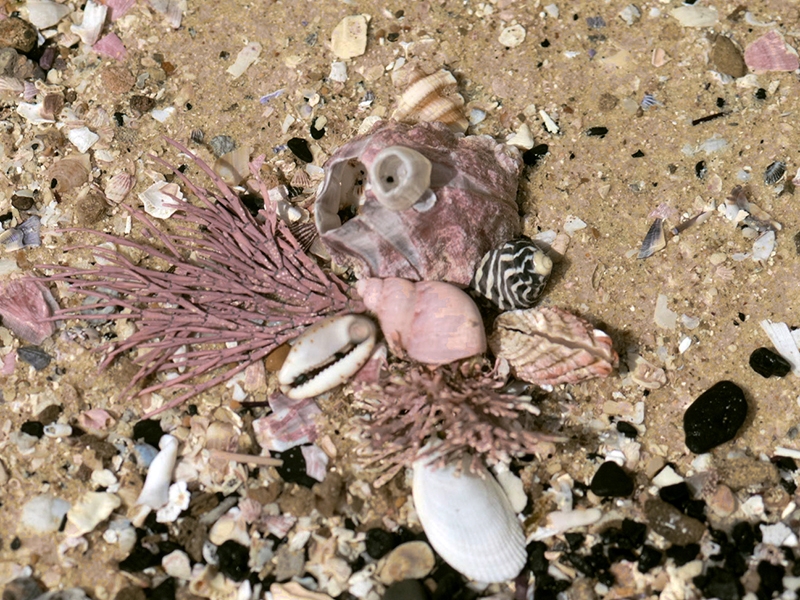
Jewelry artist Helen Britton is a pearl diver. In the seemingly mundane and carelessly overlooked objects of the world, she finds a Wunderkammer: an accumulation of stories that recount the objects’ relation to where they have been found, their points of origin, and the shape of the material. As with the picked-up shells, Britton reaches for many things, palpating their textures, paying attention and admiring them, and peeling the objects from the careless indifferences of the world. Under her hand and gaze, Britton thus transforms what she finds into something valuable, which is the first step toward her art. The Things I See was the title of one of her first solo exhibitions, in which she presented drawings, her sketchbook, and collections of colorful objects made of metal, gemstones, glass, plastic, and jewelry fashioned from raw, spiky metal. She is an artist who works in many disciplines, and could be one of the collectors memorialized by French filmmaker and documentary legend Agnès Varda in her film Les Glaneurs et la Glaneuse.
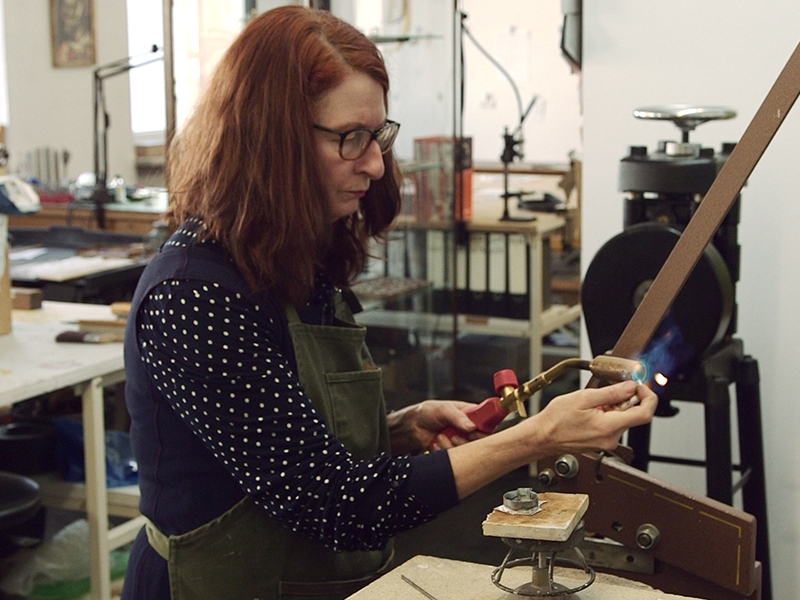
For Britton, what is left and what has been thrown away are treasures. As soon as she sees them, as soon as she touches them, she transforms them into the proverbial gold. But not really, of course, unlike in the fatal tale of King Midas. The jewelry artist distrusts precious metal. The world as it is is gold enough for her.

Director Elena Alvarez Lutz has made a touching, poetic documentary about the artist, who exhibits not only her jewelry art but also paintings, photographs, and expansive sculptures. Alvarez Lutz sees Britton as more of a hunter than a collector, and has thus named her film Hunter from Elsewhere. The filmmaker accompanied the artist on her forays over several years; Britton’s hunting grounds are seemingly unspectacular landscapes and places: the shallow waters of an Australian city beach, an industrial site cordoned off by fences, a German hardware store filled to the ceiling with buttons and notions, even a souvenir stand or flea markets. Right at the beginning of the film, we are immersed with her in an abandoned and half-ruined house, where Britton takes a close look at all sorts of things left behind. She appreciates each object, lifting it up and contemplating it.
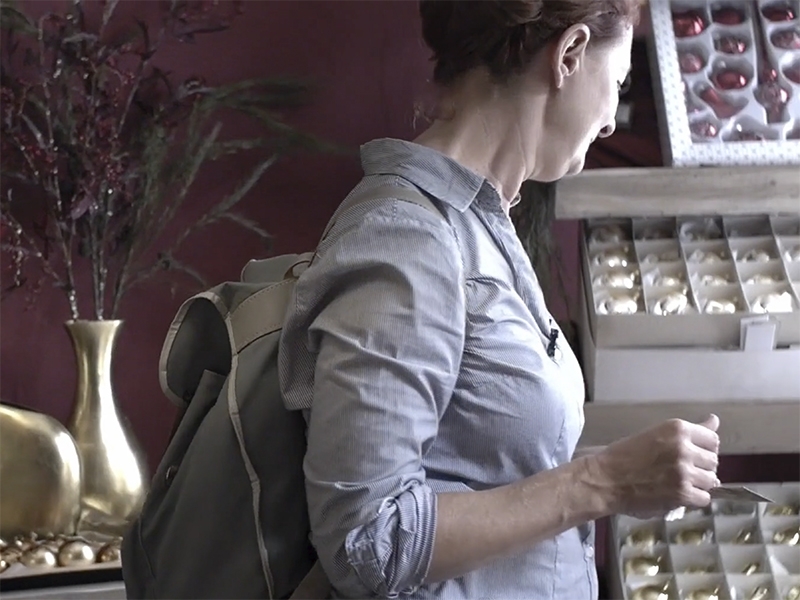
A soft voice-over, spoken by Leoncia Flynn, whose voice is reminiscent of Tilda Swinton’s, poetically recounts the artist’s view of the world. Alvarez Lutz wrote the text herself from a semifictional first-person perspective. In it, she artfully interweaves fragments from her own and Britton’s biographies; the paths of the filmmaker and the artist crossed early on. In Alvarez Lutz’s work, Britton’s world remains suspended, with a reverberation into meaningful depths in which cursory philosophical interjections emerge: on objects and the memories hidden within them, on Britton’s Australian homeland and homesickness in a foreign land, on the transformation of materials and of life as a whole. “Memories are looking at you, waiting to come alive,” we are told.
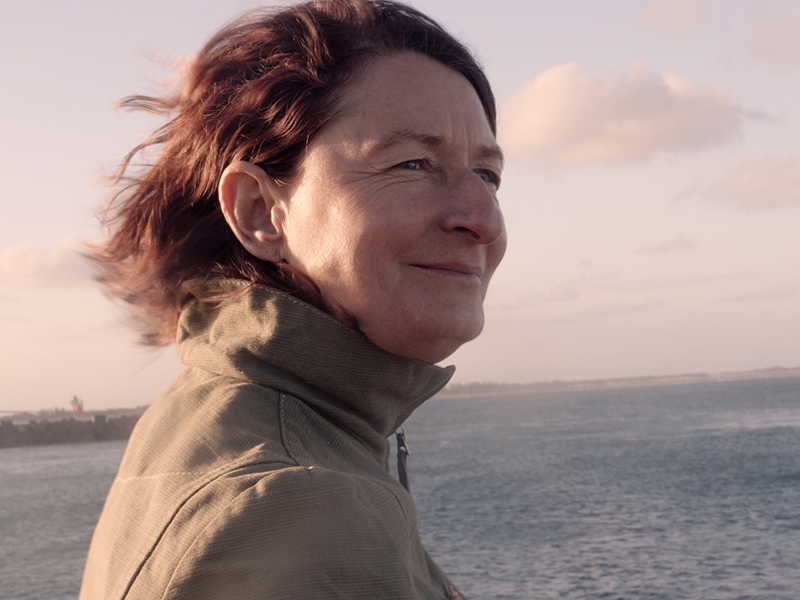
After studying fine arts in Perth, Australia, Britton came to Munich in the late 1990s to attend the Academy of Fine Arts. Ever since jewelry pioneer Hermann Jünger banned gold from his art as a bourgeois status symbol, in the 1950s, Munich has been considered a mecca of contemporary jewelry art. Britton joined the class of Otto Künzli, a student of Jünger’s, who, with the credo “gold makes you blind,” hid the precious metal under such banal materials as rubber tubing and turned it into genuine understatement jewelry.
One of Britton’s first assignments as a student in Munich was to translate a film into a piece of jewelry. It was Robert Guédiguian’s feature film Marius et Jeannette, a love story set in the port of Marseilles and flooded with Mediterranean light. Britton translated the lovers’ story into a brooch she made from a toothbrush, an object that symbolizes the beginning and end of love. Her talent for finding the philosophical essence of life in the ordinary has characterized her jewelry art ever since.

As if it were a transposition of this initiatory task, the German-Spanish director Alvarez Lutz (who has in common with Britton the wandering between her home country and her place of work in Munich) now translates Britton’s art into a film. With her camera, Alvarez Lutz unveils the objects from her surroundings, unobtrusively stages them, and gives them a foreboding quality. A plastic watering can shimmers pale in the darkness of the abandoned house, the varnish on a weathered tin plate peels off as if it were the work of an old master. Britton and Alvarez Lutz are alchemists whose gazes transform the mundane into something extraordinary and valuable. Nina Ergang’s editing condenses the images into a fluid universe, and the electro sound of Driftmachine and the organic sounds of The Notwist make it float. This continues to reverberate even after the film is over.
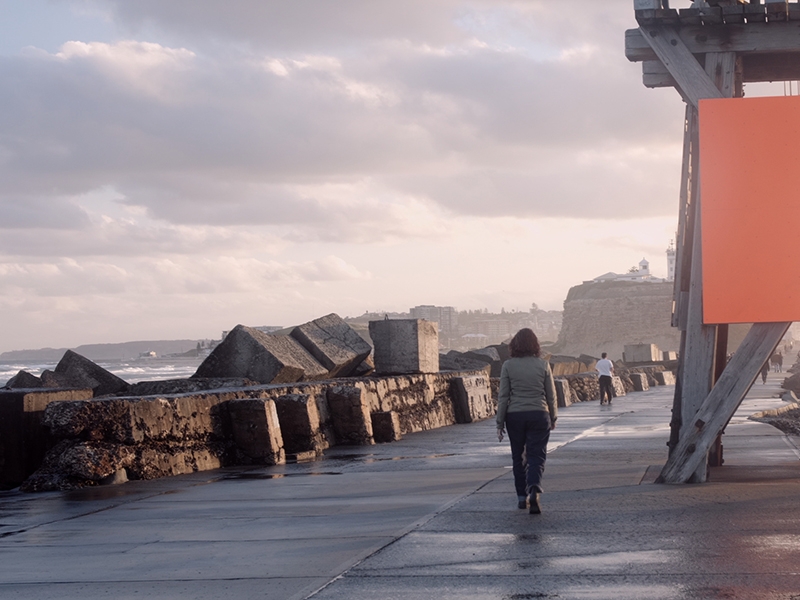
Alvarez Lutz describes her film as “a journey with Helen Britton.” She deliberately avoided portraiture, preferring to immerse the film in the universe of Britton’s life and thus come much closer to the artist. Britton grew up in Newcastle, in the southeast of Australia, in a small town devoted to heavy industry directly on the ocean. There, she grew up under the influence of globalization and saw how heavy steel was turned into ships carrying goods to the rest of the world. With archival footage of Newcastle, Alvarez Lutz brings back that golden age of heavy industry. We understand why steel is more precious to Britton than its diamond derivative, because it means life and kinship to her. The roughness and rawness of steel shaped her youth, when she disassembled motorcycles in the workshops of Newcastle and listened to post-punk. In fact, her life was quite prosaic and yet full of poetry; Britton philosophizes about life, but she doesn’t romanticize.
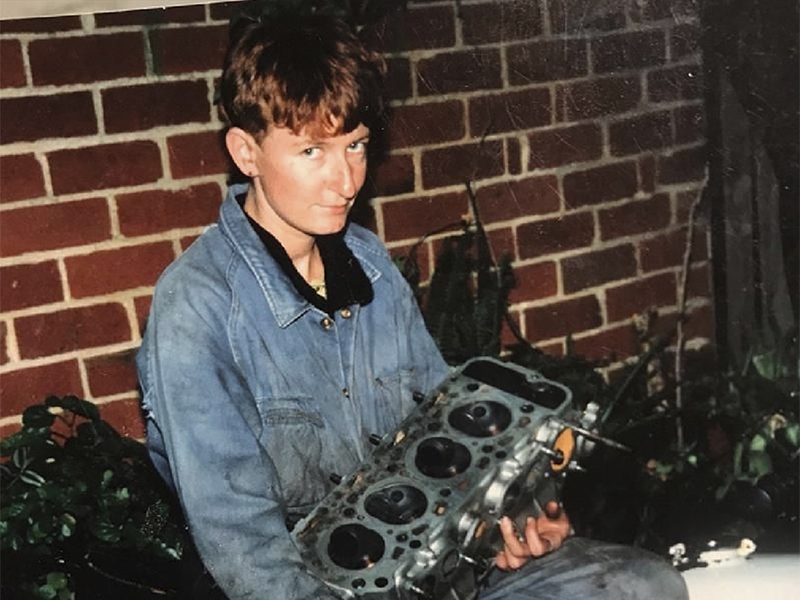
Today, Britton has a studio in Munich. The Bavarian city near the Alps is her home base for her forays into the world. Alvarez Lutz accompanies her to the manufactories of craftsmanship, to the glassblowing workshops of the Thuringian Forest that produce typical German Christmas tree decorations, filigree figurines whose kitsch Britton admires. She learned much of her craft in Idar-Oberstein, where the film also follows her. This town in the Hunsrück mountain range, near the Luxembourg border, is the epicenter of gemstone art. She came to the tranquil place as an artist in residence and learned important techniques of material transformation on the machines of the manufactories, but also modified the machines for her artistic purposes. “You always had to de-adjust the machines for her,” recalls one of her teachers.

Britton finds the objects for her art in things thrown away and left behind, but also in the leftover materials of gem collectors and glassblowers. She arranges the discarded fragments in her art, into a bunch of keys made of delicate gem pins, or she smashes the colorful glass, casts it in cement, and produces a sculpture evocative of a house, just as she learned in Thuringia. At the time of filming, an exhibition was in the works, and the documentary shows her preparation with jewelry artist Felix Lindner. Sentimental Journey is what Britton calls the show. The German artist says Heimat [editor’s note: this translates as homeland].
To have come from somewhere else, to a new and foreign world, to always feel homesick for the Land Down Under in Europe, is essential for Britton’s art of object transformation, she says in the film, from her studio in Munich. “In the world you live in, everything seems ordinary, everyday to you. But if you come from somewhere else, you look at this banality quite differently: everything seems unusual and special to you.” Helen Britton is a hunter from elsewhere. She brings us the flowers of the banal. Elena Alvarez Lutz’s film hands us the key to this rich Wunderkammer.[i]

Die Alchemistinnen
Helen Britton ist eine der eminenten zeitgenössischen Künstlerinnen, die Profanes in Preziosen zu verwandeln weiß. Elena Alvarez Lutz hat ihre Philosophie jetzt in einen Film verwandelt. Diese Kritik basiert auf der deutschen Erstaufführung des Dokumentarfilms beim Dok.Fest München. Alvarez Lutz hat den Dokumentarfilm bei Filmfestivals auf der ganzen Welt eingereicht, Sie sollten also bald Gelegenheit haben, ihn zu sehen. Wenn AJF Informationen zu Vorführungen erhält, aktualisieren wir diese Seite und den Bericht.
Mit nackten Füßen durchstreift Helen Britton den gefluteten Sandstrand von Newcastle im Südosten von Australien. Zwischen dem grünen Tang stößt sie auf eine zartrosé-farbene Muschel, daneben eine abgeworfene Cirripediaschale mit vielen Öffnungen, die aussieht wie ein kleines Ufo. Sie klaubt die Schalen auf, arrangiert sie zu einem handtellergroßen Ensemble. Mit ihrem Finger deutet sie auf die gerundeten Formen der Schaleneingänge, die leer und verlassen von seinem ehemaligen Bewohner, dem Krebs, klaffen, erwähnt das auffällige Purpur der Hülle. „Das ist typisch für die Region“, sagt sie.
Die Schmuckkünstlerin Helen Britton ist eine Perlentaucherin. In scheinbar profanen und leichtfertig übersehenen Objekten der Welt findet sie eine „Wunderkammer“: eine Ansammlung von Geschichten, die von der Verbundenheit der Objekte mit ihrem Fundort erzählen, von der Region, in der sie beheimatet sind, und von der Gewachsenheit und den Formen des Materials. Wie nach den aufgeklaubten Schalen greift Britton nach vielen Dingen, betastet ihre Textur, schenkt ihnen Beachtung und Bewunderung und entschält die Objekte der achtlosen Indifferenz der Welt. Unter ihrer Hand und ihrem Blick verwandelt Britton so das Gefundene zu etwas Wertvollem, das ist der erste Schritt zu ihrer Kunst. „The Things I See“ hieß so auch eine ihrer ersten Solo-Ausstellungen, in der sie Zeichnungen, ihr Skizzenbuch und Ansammlungen von bunten Objekten aus Metall, Edelsteinen, Glas, Plastik und aus rohem, stacheligem Metall gefertigte Schmuckstücke präsentierte. Die in vielen Disziplinen arbeitende Künstlerin Helen Britton könnte eine von den Sammlerinnen sein, denen die französische Filmemacherin und Dokumentarfilmlegende Agnès Varda in ihrem Film Les glaneurs et la glaneuse ein Denkmal gesetzt hat.
Das Übriggebliebenene und das Weggeworfene sind für Helen Britton Schätze. Kaum sieht sie sie, kaum berührt sie sie, verwandelt sie diese in das sprichwörtliche Gold. Aber natürlich nicht wirklich, anders als in der fatalen Sage von König Midas. Die Schmuckkünstlerin misstraut dem Edelmetall. Die Welt, wie sie ist, ist für Helen Britton Gold genug.
Jetzt hat die Regisseurin Elena Alvarez Lutz einen berührend-poetischen Dokumentarfilm über die Künstlerin gemacht, die neben ihrer Schmuckkunst auch Malerei, Fotografien und raumgreifende Skultpuren ausstellt. Alvarez Lutz sieht in Britton mehr ein Jägerin denn eine Sammlerin und hat so ihren Film geannt: HUNTER FROM ELSEWHERE. Die Filmemacherin Alvarez Lutz hat die Künstlerin über mehrere Jahre bei den Streifzügen begleitet, Brittons Jagdreviere sind scheinbar unspektakuläre Landschaften und Orte, in Australien das seichte Gewässer an einem Stadtstrand, ein von Zäunen abgesperrtes Industriegelände, in Deutschland ein bis zur Decke mit Knöpfen und Kurzwaren gefüllter Kramerladen, auch ein Souvenir-Stand oder Flohmärkte. Gleich zu Beginn des Films tauchen wir mit ihr in ein verlassenes und halbverfallenes Haus ein, in dem Britton den durcheinandergeratenen Nachlass in Augenschein nimmt. Jedes Objekt würdigt sie, hebt es hoch und betrachtet es.
Eine weiche Voice-Over-Stimme, gesprochen von Leoncia Flynn, deren Sound an Tilda Swinton erinnert, erzählt mit poetischen Worten von der Sichtweise der Künstlerin auf die Welt. Alvarez Lutz hat den Text aus einer semi-fiktionalen Ich-Perspektive selbst geschrieben. Kunstvoll verwebt sie darin Bruchstücke aus ihrer und Brittons Biographie; die Wege der Filmemacherin und der Künstlerin haben sich schon früh gekreuzt. Die Welt von Helen Britton bleibt bei Alvarez Lutz schwebend, mit einem Nachhall in bedeutungsschwere Tiefen, in denen sich skizzenaft philosophische Einlassungen auftun: zu den Gegenständen und den in ihnen verborgenen Erinnerungen, zur australischen Heimat und dem Heimweh in der Fremde, zur Transformation der Materialien und des Lebens insgesamt. „Memories are looking at you, waiting to come alive“, heißt es einmal.
Helen Britton kam Ende der 1990er Jahre nach ihrem Studium der Bildenden Kunst im australischen Perth nach München an die Akademie der Bildenden Künste. Seit dort der Schmuck-Pionier Hermann Jünger in den 1950er Jahren das Gold als bourgeoises Statussymbol aus seiner Kunst verbannt hatte, galt München als Mekka der zeitgenössischen Schmuckkunst. Britton kam in die Klasse von Otto Künzli, einem Schüler von Jünger, der mit dem Credo „Gold macht blind“ das Edelmetall in so banalen Materialien wie Gummischläuche versteckte und daraus echten Understatement-Schmuck machte.
Als eine der ersten Studienaufgaben sollte Britton in München einen Film in ein Schmuckstück übersetzen. Es ging um Robert Guédiguians Spielfilm Marius et Jeannette, einer von mediterranem Licht durchfluteten Liebesgeschichte im Hafen von Marseille. Britton übersetzte die Geschichte des Liebespaares in eine Brosche, die sie aus einer Zahnbürste fertigte – einem Gegenstand, der den Beginn und das Ende von Liebe symbolisiert. Elena Alvarez Lutz war damals in der Jury und sollte die Aufgaben bewerten. Die Begabung von Helen Britton, in den Dingen des Lebens auch die lebensphilosophische Essenz zu finden, beeindruckte die Filmemacherin zutiefst.
Wie in Umkehrung dieser Initialaufgabe übersetzt nun die deutsch-spanische Regisseurin Elena Alvarez Lutz, die mit Britton das Wandern zwischen der Heimat und ihrem Wirkungsort München gemeinsam hat, die Kunst von Helen Britton in einen Film. Mit der Kamera entbirgt sie die Gegenstände aus ihrer Umgebung, setzt sie ganz unauffällig in Szene und verleiht ihnen eine ahnungsvolle Wertigkeit. Eine Plastikgießkanne lässt sie fahl im Dunkel des verlassenen Nachlass-Hauses schimmern, eine verwitterte Blechtafel blättert ihren Lack ab, als wäre sie das Kunstwerk eines alten Meisters. Helen Britton und Elena Alvarez Lutz sind Alchemistinnen, unter deren Blick sich das Profane in etwas Besonderes und Wertvolles verwandelt. Die Montage von Nina Ergang verdichtet die Bilder zu einem fluiden Universum, der Elektrosound von Driftmachine und die organischen Klänge von The Notwist bringen es zum Schweben. Das hallt auch nach dem Film noch nach.
„A journey with Helen Britton“ beschreibt Alvarez Lutz ihren Film. Absichtlich hat sie das Portrait vermieden, taucht lieber mit ihr in das Universum ihres Lebens ein und kommt der Künstlerin so ungleich näher. Aufgewachsen ist Helen Britton in Newcastle im Südosten Australiens, in einer auf Schwerindustrie getrimmten Kleinstadt direkt am Ozean. Hier wurde sie unter dem Eindruck der Materialverwandlung groß, erlebte, wie schwerer Stahl zu Schiffen wurde, die mit Waren in die weite Welt hinausfuhren. Mit dokumentarischen Archivaufnahmen von Newcastle bringt Alvarez Lutz diese goldene Zeit des schwerindustriellen Zeitalters zurück. Der Stahl ist für Helen Britton wertvoller als sein Diamant-Derivat, weil er für sie das Leben und die Verwandlung bedeutet. Das Roughe und Raue prägte ihre Jugend, in der sie in den Werkstätten von Newcastle Motorräder auseinanderbaute und Postpunk hörte. Eigentlich war ihr Leben ziemlich prosaisch und trotzdem voll Poesie; Britton philosophiert über das Leben, aber sie romantisiert nicht.
Heute hat Britton ein Atelier in München. Die bayerische Stadt nahe der Alpen ist für sie „home base“ für die Streifzüge durch die Welt. Alvarez Lutz begleitet sie in die Manufakturen der Handwerkskunst, in die Glasbläserstätten des Thüringer Walds, die den typisch deutschen Christbaumschmuck herstellen, filigrane Figurinen, deren Kitsch Helen Britton bewundert. Viel von ihrem Handwerk hat sie in Idar-Oberstein gelernt, auch dahin führt der Film. Der Ort am Hunsrück nahe der luxemburgischen Grenze ist das Epizentrum der Edelsteinkunst. Sie kam als Artist in Residence in den beschaulichen Ort und lernte an den Maschinen der Manufakturen wichtige Techniken der Materialtransformation, veränderte die Maschinen aber auch für ihre künstlerischen Zwecke. „Immer musste man die Maschinen für sie dejustieren“, erinnert sich einer ihrer Lehrmeister.
Helen Britton findet die Objekte für ihre Kunst im Trödel und Nachlässen, aber auch in den Material-Resten der Gesteinssammlern und Glasbläserinnen. oder sie zertrümmert das bunte Glas, gießt es in Zement und deutet ein Haus an, so wie sie sie in Thüringen kennengelernt hat. Eine Ausstellung wird daraus, der Film zeigt sie bei den Vorbereitungen mit dem Schmuckkünstler Felix Lindner. „Sentimental journey“ nennt Britton die Schau, der deutsche Künstler sagt „Heimat“.
Woanders hergekommen zu sein, in eine neue und fremde Welt, immer wieder in Europa auch Heimweh nach dem australischen Down Under zu verspüren, ist für ihre Kunst der Objekt-Transformation wesentlich, erzählt Helen Britton im Film in ihrem Atelier in München. „In der Welt, in der du lebst, erscheint dir alles gewöhnlich, alltäglich. Kommst du aber von woanders her, blickst du ganz anders auf diese Banalität: Alles erscheint dir ungewöhnlich und besonders.“ Helen Britton ist eine Jägerin aus einer anderen Welt. Sie ist gekommen, um uns die Blumen des Banalen zu überreichen. Elena Alvarez Lutz’ Film gibt uns den Schlüssel zu dieser reichen Wunderkammer in die Hand.






